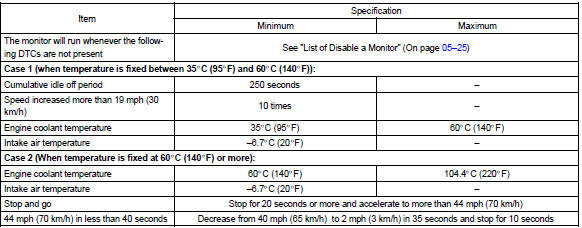Toyota Corolla (E120) 2002–2008 Repair Manual / Diagnostics / Sfi system / Engine coolant temp. Circuit
range/performance problem / Circuit description
Toyota Corolla (E120): Circuit description
Refer to dtc p0115
|
Dtc no. |
Dtc detection condition | Trouble area |
| P0116 | If engine coolant temperature (ect) was between 35 c (95 °F)
and 60 c (140 °F) when starting the engine, and also conditions
(a) and (b) are met:
|
|
If engine coolant temperature (ect) was more than 60 c
when starting the engine, and also conditions (a) and (b) are
met:
|
Monitor description
The engine coolant temperature (ect) sensor is used to monitor the engine coolant temperature. The ect sensor has a thermistor that varies its resistance depending on the temperature of the engine coolant. When the coolant temperature is low, the resistance in the thermistor increases. When the temperature is high, the resistance drops. The variations in resistance are reflected in the voltage output from the sensor. The ecm monitors the sensor voltage and uses this value to calculate the engine coolant temperature. When the sensor output voltage deviates from the normal operating range, the ecm interprets this as a fault in the ect sensor and sets a dtc.
Examples:
- upon starting the engine, the coolant temperature (ect) was
between 35 c (95 °F) and 60 c (140 °F).
If after driving for 250 seconds, the ect still remains within 3 c (5.4 °F) of the staring temperature, a dtc will be set. (2 Trip detection logic)
- upon starting the engine, the coolant temperature (ect) was over 60 c (140 °F). If after driving for 250 seconds, the ect still remains within 1 c (1.8 °F) of the starting temperature, a dtc will be set. (6 Trip detection logic)
Monitor strategy

Typical enabling conditions

Typical malfunction thresholds

Component operating range

Wiring diagram
Refer to dtc p0115
Other materials:
Emergency flashers
The emergency flashers are
used to warn other drivers
when the vehicle has to be
stopped on the road due to
a breakdown, etc.
Operating instructions
Press the switch.
All the turn signal lights will flash.
To turn them off, press the switch
once again.
■Emergency flashers
If the emergency fla ...
On–vehicle inspection
Notice:
”cold” and ”hot” in these sentences express the temperature of the coils
themselves. ”Cold” is from
–10 c (14 f) to 50 c (122 f) and ”hot” is from 50 c (122 f) to 100 c (212 f).
1. Inspect ignition coil (with igniter) and spark test
confirm dtc.
Notice:
...
Malfunction in water temperature receiver gauge
Wiring diagram
Inspection procedure
1 Read value of hand–held tester
Check output value of ecm.
Connect the hand–held tester to dlc3.
Turn the ignition switch to on and push the hand–held tester main
switch on.
Select the data list mode on the hand–he ...


